The Management of Polymer and Biodegradable Composite Waste in Relation to Petroleum-Based Thermoplastic Polymer Waste—In Terms of Energy Consumption and Processability
Abstract
1. Introduction
2. Review of the Literature
2.1. Waste Management
- The magnitude and quality (homogeneity, purity, toxicity) of the waste stream gathered under selective collection,
- Available sorting technologies,
- Market demand for products recovered from plastic waste and the requirements concerning their quality.
2.2. Statistical Data-Scale of the WM Problem
2.3. Biodegradable Plastic Waste Management
3. Results and Discussion
3.1. Method and Research Questions
- Q1: Is there an impact of retreatment on technological indicators defined by means of the mass flow rate?
- Q2: Is the retreatment of biodegradable plastics justified in terms of economy, energy and ecology?
- Q3: Is the retreatment of biodegradable plastics efficient?
- Polymer materials produced from petroleum: PE, PET, PA 6.6,
- Biodegradable materials: polylactide (PLA IngeoBiopolymer 4043D), Bioplast 105 (a thermoplastic that contains a large amount of bio-based materials) and Bioplast 300 (a thermoplastic polymer containing natural potato starch and other bio-based polymers).
3.2. Research Results
4. Conclusions
Author Contributions
Funding
Institutional Review Board Statement
Informed Consent Statement
Data Availability Statement
Conflicts of Interest
References
- Hyman, M.; Turner, B.; Carpintero, A. Guidelines for National Waste Management Strategies. Moving from Challenges Opportunities. 2013. ISBN 978-92-807-3333-4. Available online: https://cwm.unitar.org/national-profiles/publications/cw/wm/UNEP_UNITAR_NWMS_English.pdf (accessed on 21 October 2020).
- Art. 11 and 191–193 Traktatu o Funkcjonowaniu Unii Europejskiej (The Treaty on the Functioning of the European Union). Version from EUR-Lex dated 01/03/2020, Lisbon, Portugal. Available online: https://eur-lex.europa.eu/legal-content/PL/TXT/?uri=CELEX%3A02016E%2FTXT-20200301 (accessed on 21 October 2020).
- Cusenza, M.A.; Longo, S.; Guarino, F.; Cellura, M. Energy and environmental assessment of residual bio-wastes management strategies. J. Clean. Prod. 2021, 285, 124815. [Google Scholar] [CrossRef]
- Hoornweg, D.; Bhada-Tata, P. What a Waste: A Global Review of Solid Waste Management. 2012. Available online: https://openknowledge.worldbank.org/handle/10986/17388 (accessed on 16 October 2020).
- Ferronato, N.; Torretta, V. Waste Mismanagement in Developing Countries: A Review of Global Issues. Int. J. Environ. Res. Public Health 2019, 16, 1060. [Google Scholar] [CrossRef]
- Koval, V.; Mikhno, I. Ecological sustainability preservation of national economy by waste management methods. Econ. Ecol. Socium 2019, 3, 30–40. [Google Scholar] [CrossRef]
- Buclet, N.; Godard, O. The evolution of municipal waste management in Europe: How different are national regimes? J. Environ. Policy Plan. 2001, 3, 303–317. [Google Scholar] [CrossRef]
- Faraca, G.; Astrup, T. Plastic waste from recycling centres: Characterisation and evaluation of plastic recyclability. Waste Manag. 2019, 95, 388–398. [Google Scholar] [CrossRef]
- Bodzay, B.; Bánhegyi, G. Polymer waste: Controlled breakdown or recycling? Int. J. Des. Sci. Technol. 2016, 22, 109–138. [Google Scholar]
- Agamuthu, P.; Khidzir, K.; Hamid, F.S. Drivers of sustainable waste management in Asia. Waste Manag. Res. 2009, 27, 625–633. [Google Scholar] [CrossRef]
- Contreras, F.; Ishii, S.; Aramaki, T.; Hanaki, K.; Connors, S. Drivers in current and future municipal solid waste management systems: Cases in Yokohama and Boston. Waste Manag. Res. 2009, 28, 76–93. [Google Scholar] [CrossRef] [PubMed]
- Marshall, R.E.; Farahbakhsh, K. Systems approaches to integrated solid waste management in developing countries. Waste Manag. 2013, 33, 988–1003. [Google Scholar] [CrossRef]
- Sotamenou, J.; De Jaeger, S.; Rousseau, S. Drivers of legal and illegal solid waste disposal in the Global South—The case of households in Yaoundé (Cameroon). J. Environ. Manag. 2019, 240, 321–330. [Google Scholar] [CrossRef]
- Wilson, D.C.; Velis, C.; Cheeseman, C. Role of informal sector recycling in waste management in developing countries. Habitat Int. 2006, 30, 797–808. [Google Scholar] [CrossRef]
- Dayana, S.; Sharuddin, A.; Abnisa, F.; Daud, W.; Aroua, M. Energy recovery from pyrolysis of plastic waste: Study on non-recycled plastics (NRP) data as the real measure of plastic waste. Energy. Convers. Manag. 2017, 148, 925–934. [Google Scholar] [CrossRef]
- Geyer, R.; Jambeck, J.R.; Law, K.L. Production, use, and fate of all plastics ever made. Sci. Adv. 2017, 3, e1700782. [Google Scholar] [CrossRef]
- Rydzkowski, T. Recykling odpadowych tworzyw polimerowych. Recykling 2009, 5, 25. [Google Scholar]
- Wróblewska-Krepsztul, J.; Rydzkowski, T. Pyrolysis and incineration in polymer waste management system. J. Mech. Energy Eng. 2020, 3, 337–342. [Google Scholar] [CrossRef]
- European Parliament. Available online: https://www.europarl.europa.eu/news/pl/headlines/society/20181212STO21610/odpady-z-tworzyw-sztucznych-i-recykling-w-ue-fakty-i-liczby (accessed on 15 October 2020).
- Tulashie, S.K.; Boadu, E.K.; Kotoka, F.; Mensah, D. Plastic wastes to pavement blocks: A significant alternative way to reducing plastic wastes generation and accumulation in Ghana. Constr. Build. Mater. 2020, 241, 118044. [Google Scholar] [CrossRef]
- Hermabessiere, L.; Dehaut, A.; Paul-Pont, I.; Lacroix, C.; Jezequel, R.; Soudant, P.; Duflos, G. Occurrence and effects of plastic additives on marine environments and organisms: A review. Chemosphere 2017, 182, 781–793. [Google Scholar] [CrossRef]
- UNEP. 2018b, Emissions Gap Report 2018. 27 November 2018. Available online: https://www.unenvironment.org/resources/emissions-gap-report (accessed on 11 November 2020).
- Wu, W.-M.; Yang, J.; Criddle, C.S. Microplastics pollution and reduction strategies. Front. Environ. Sci. Eng. 2017, 11, 6. [Google Scholar] [CrossRef]
- Ayeleru, O.O.; Dlova, S.; Akinribide, O.J.; Ntuli, F.; Kupolati, W.K.; Marina, P.F.; Blencowe, A.; Olubambi, P.A. Challenges of plastic waste generation and management in sub-Saharan Africa: A review. Waste Manag. 2020, 110, 24–42. [Google Scholar] [CrossRef]
- PlasticsEurope. Plastics—The Facts 2019. An Analysis of European Plastics Production, Demand and Waste Data. Brussels, Belgium. 2019. Available online: https://www.plasticseurope.org/application/files/9715/7129/9584/FINAL_web_version_Plastics_the_facts2019_14102019.pdf (accessed on 12 March 2021).
- European Commission, Environment. Available online: https://ec.europa.eu/environment/topics/waste-and-recycling_en (accessed on 16 October 2020).
- Biotworzywa—Ekologiczny kierunek rozwoju tworzyw sztucznych. Available online: https://www.kierunekchemia.pl/artykul,59603,biotworzywa-ekologiczny-kierunek-rozwoju-tworzyw-sztucznych.html (accessed on 21 October 2020).
- Francis, R. Recycling of Polymers: Methods, Characterization and Applications; John Wiley & Sons: Hoboken, NJ, USA, 2016; ISBN 978-3-527-33848-1. [Google Scholar]
- Banks, S.; Bridgwater, A. Catalytic fast pyrolysis for improved liquid quality. In Handbook of Biofuels Production; Luque, R., Lin, C.S.K., Wilson, K., Clark, J., Eds.; Woodhead Publishing: Cambridge, MA, USA, 2016; pp. 391–429. ISBN 978-0-08-00456-2. [Google Scholar]
- Dhawan, R.; Bisht, B.M.S.; Kumar, R.; Kumari, S.; Dhawan, S. Recycling of plastic waste into tiles with reduced flammability and improved tensile strength. Process. Saf. Environ. Prot. 2019, 124, 299–307. [Google Scholar] [CrossRef]
- European Commission, Energy, Climate Change, Environment. Available online: https://ec.europa.eu/info/energy-climate-change-environment/overall-targets/2030-targets_pl (accessed on 24 October 2020).
- Guerrero, L.A.; Maas, G.; Hogland, W. Solid waste management challenges for cities in developing countries. Waste Manag. 2013, 33, 220–232. [Google Scholar] [CrossRef]
- Eurostat. Available online: https://ec.europa.eu/eurostat/statistics-explained/index.php/Waste_statistics (accessed on 19 October 2020).
- Kabasci, S. Bio-Based Plastics Materials and Applications, Fraunhofer-Institute for Environmental, Safety, and Energy Technology UM-SICHT; John Wiley & Sons, Ltd.: West Sussex, UK, 2014; ISBN 9781119994008. [Google Scholar] [CrossRef]
- European Bioplastics. Available online: https://www.european-bioplastics.org/bioplastics/waste-management/ (accessed on 20 October 2020).
- Blanco, I.; Ingrao, C.; Siracusa, V. Life-Cycle Assessment in the Polymeric Sector: A Comprehensive Review of Application Experiences on the Italian Scale. Polymers 2020, 12, 1212. [Google Scholar] [CrossRef] [PubMed]
- Borghi, G.; Pantini, S.; Rigamonti, L. Life cycle assessment of non-hazardous Construction and Demolition Waste (CDW) management in Lombardy Region (Italy). J. Clean. Prod. 2018, 184, 815–825. [Google Scholar] [CrossRef]
- Ishigaki, T.; Sugano, W.; Nakanishi, A.; Tateda, M.; Ike, M.; Fujita, M. The degradability of biodegradable plastics in aerobic and anaerobic waste landfill model reactors. Chemosphere 2004, 54, 225–233. [Google Scholar] [CrossRef]
- Sudesh, K.; Iwata, T. Sustainability of Biobased and Biodegradable Plastics. CLEAN Soil Air Water 2008, 36, 433–442. [Google Scholar] [CrossRef]
- Ren, X. Biodegradable plastics: A solution or a challenge? J. Clean. Prod. 2003, 11, 27–40. [Google Scholar] [CrossRef]
- Pudełko, A.; Malińska, K.; Postawa, P.; Stachowiak, T.; Weisser, P. Mechanical, Thermal and Morphological Properties of Bio-char Added Biocomposites. In Proceedings of the 5th International Conference on Advances in Sustainable Sewage Sludge Management (ASSM 2016), Kraków, Polska, 18–21 September 2016. [Google Scholar]
- Stachowiak, T. Product Life Cycle in Relation to the Issue of Recycling and Reuse of Waste from the Manufacture of Airbags. In Proceedings of the International Business Information Management (IBIMA), Sewilla, Spain, 1–2 April 2020. [Google Scholar]
- Stachowiak, T. Properties of Recycled Natural Fiber Reinforced Composites Materials. Acta Phys. Pol. A 2019, 135, 103–106. [Google Scholar] [CrossRef]
- Biodegradable Polymer Market worth USD 5.18 Billion in 2020. Available online: https://www.newsmaker.com.au/news/103838/biodegradable-polymer-market-worth-usd-518-billion-in-2020#.X5QQcNAzaUk (accessed on 3 November 2020).
- Narayan, R. Carbon footprint of bioplastics using biocarbon content analysis and life-cycle assessment. MRS Bull. 2011, 36, 716–721. [Google Scholar] [CrossRef]
- Bremner, T.; Rudin, A.; Cook, D.G. Melt flow index values and molecular weight distributions of commercial thermoplastics. J. Appl. Polym. Sci. 1990, 41, 1617–1627. [Google Scholar] [CrossRef]
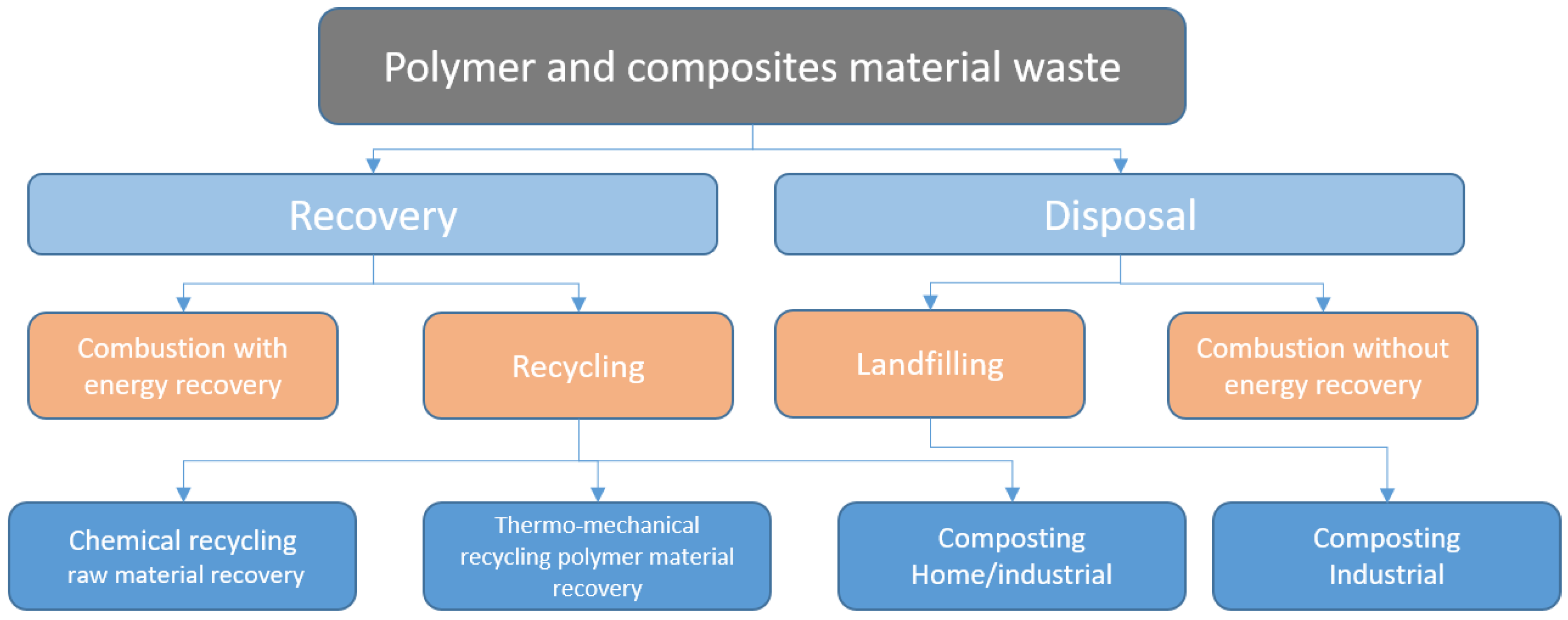
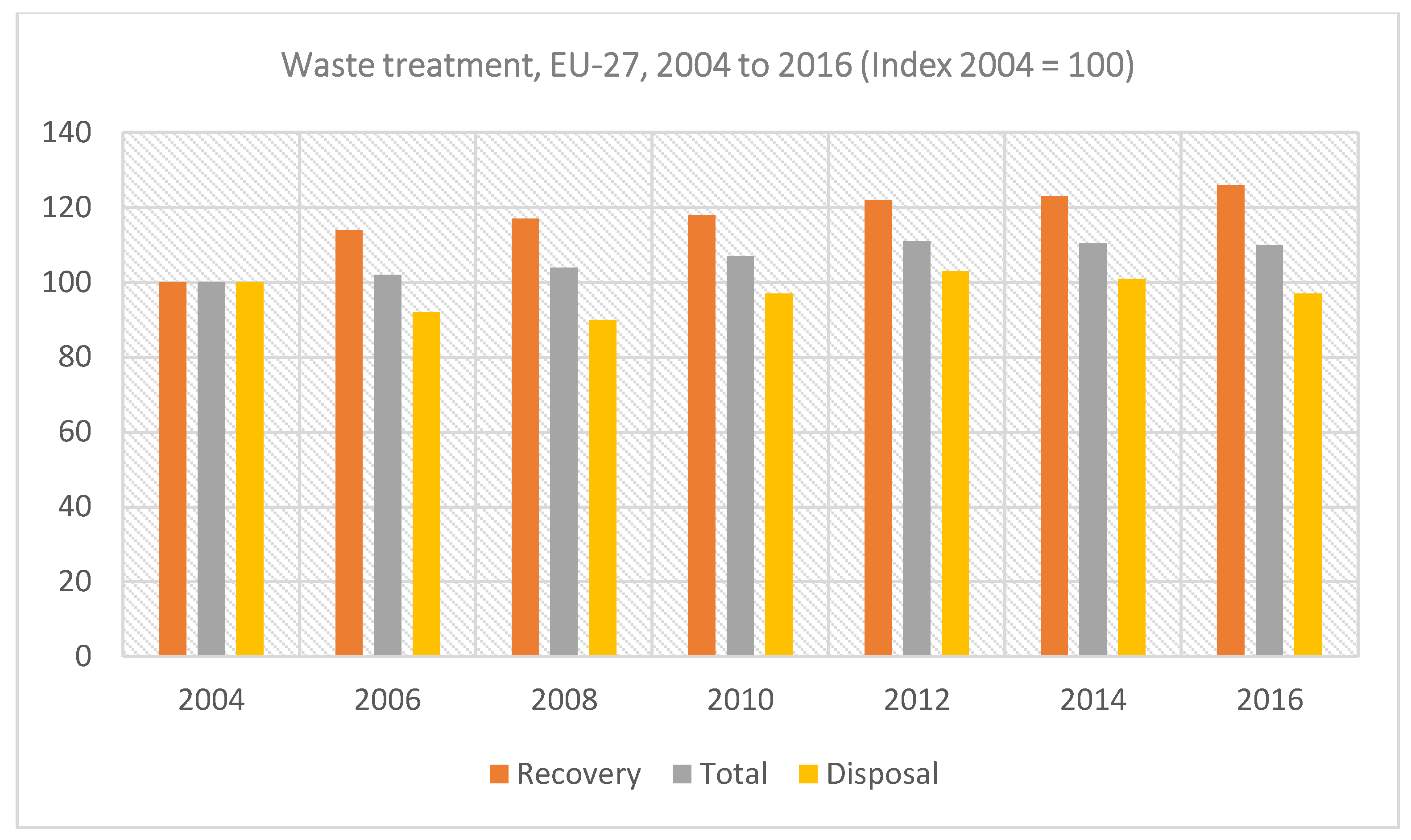
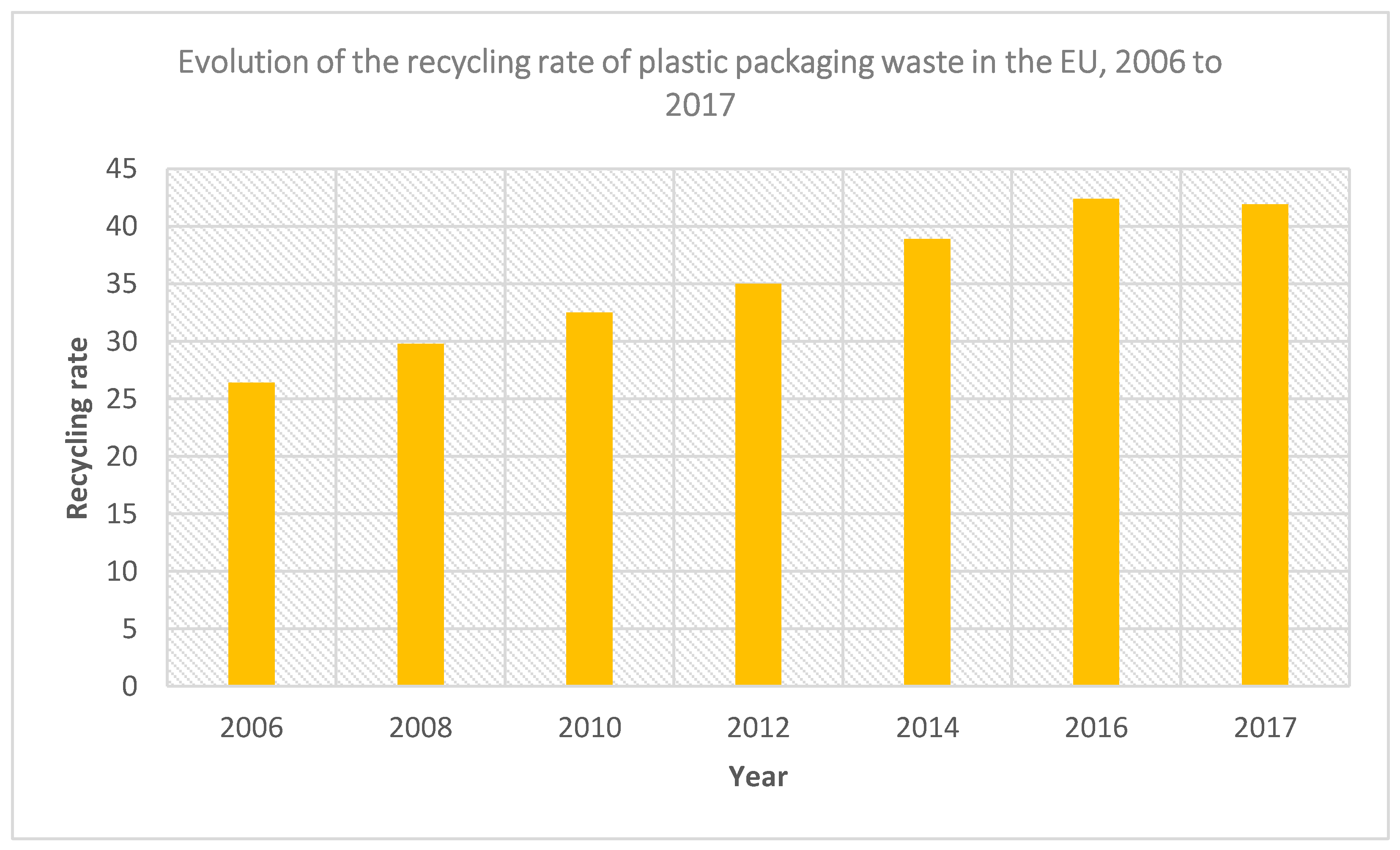

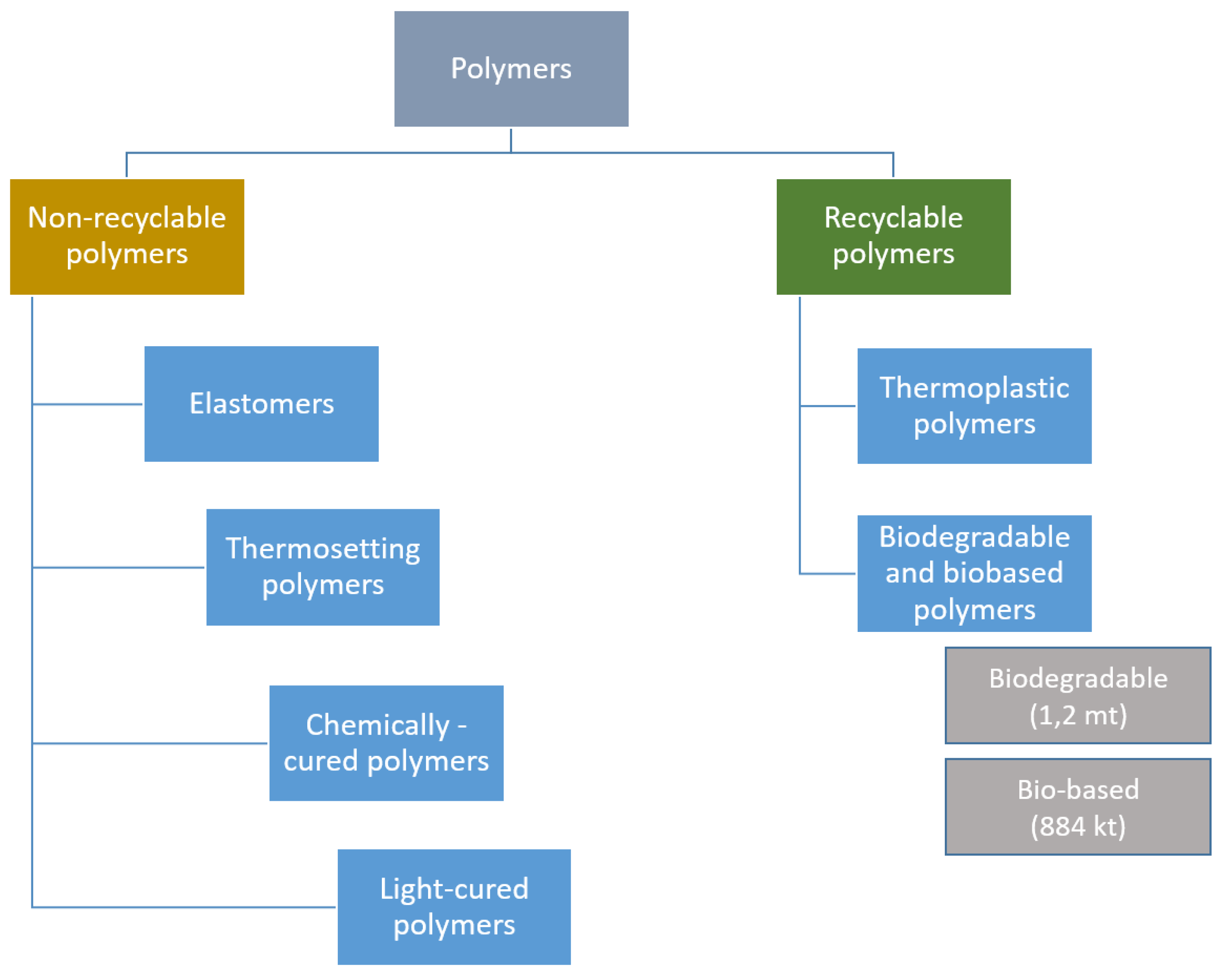
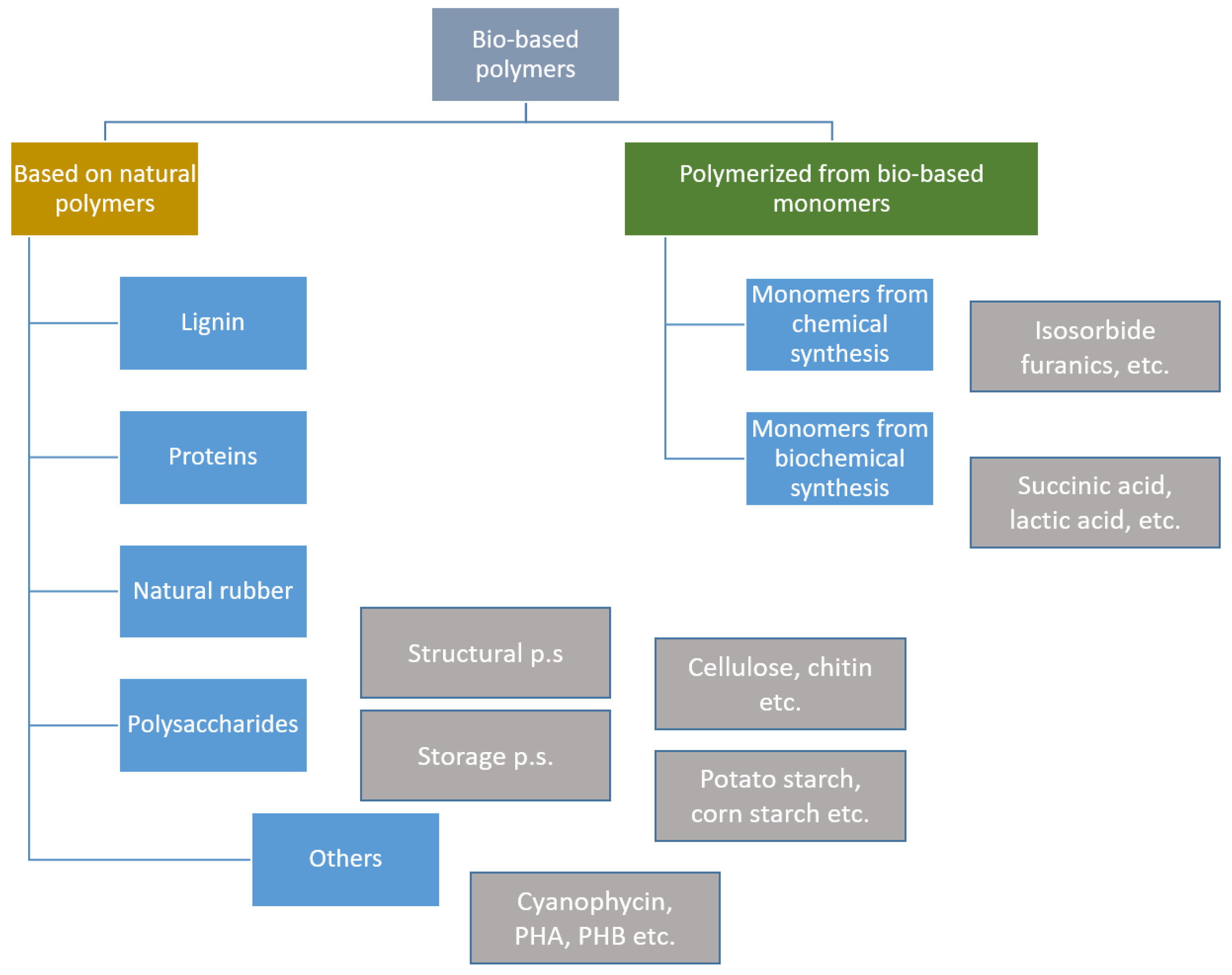
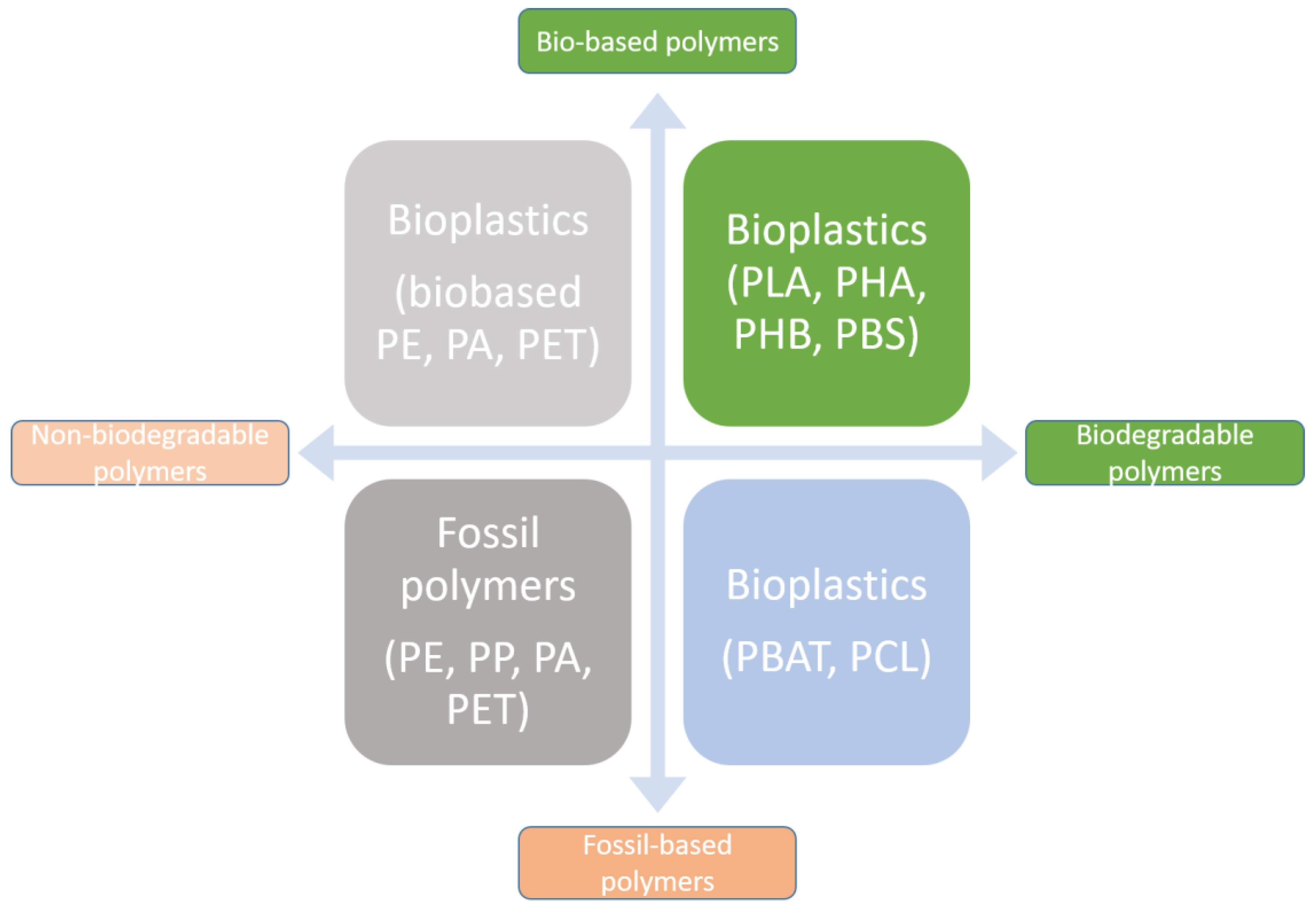
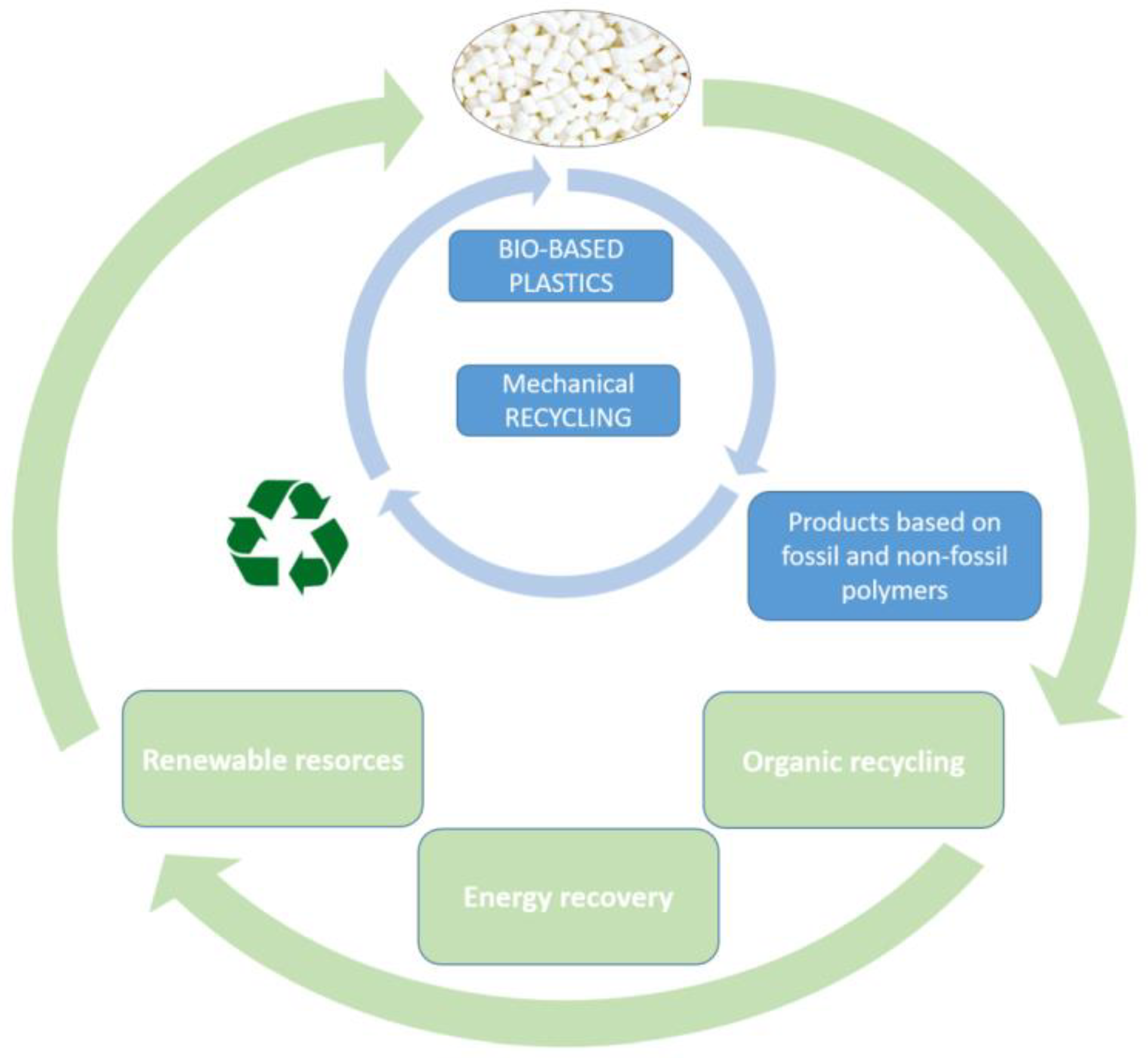
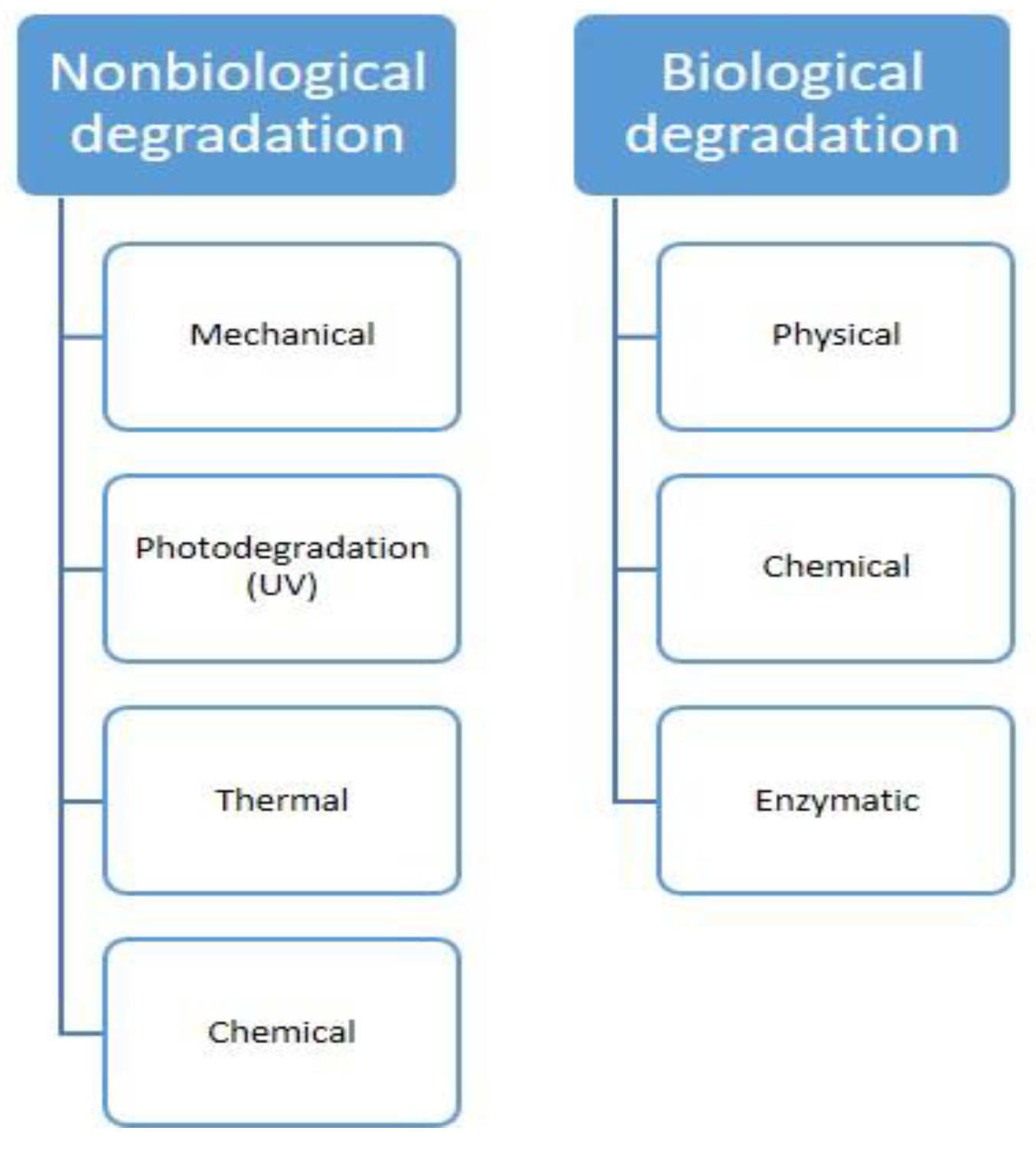



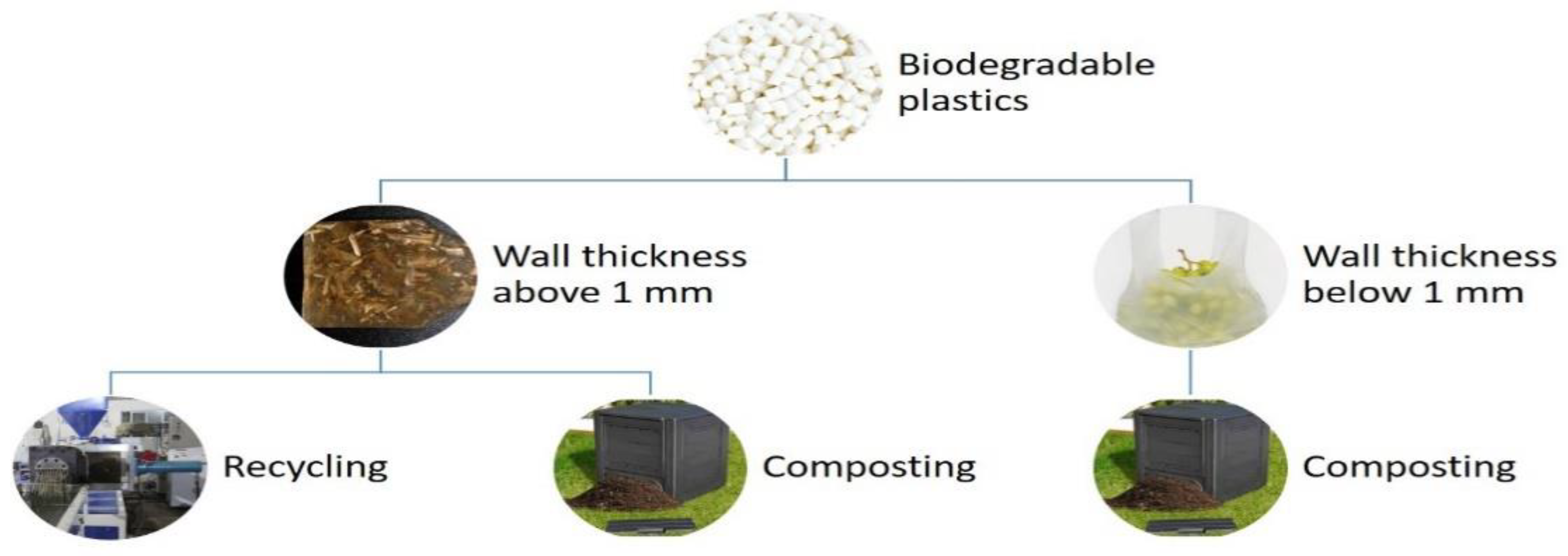
| Petroleum-Based and Biodegradable Polymers Considered in the Study | ||
|---|---|---|
| Common Plastics | Technical Plastics | Biodegradable Plastics |
| PE 0.2 | PA | PLA |
| PE 4 | PET | Bioplast 105 |
| PP 6 | Bioplast 300 | |
| Elements of the Cascade Line Used during the Tests | ||
|---|---|---|
| No. | Device Name | Rated Power [kW] |
| 1. | Compactor | 40 |
| 2. | Extruder I | 75 |
| 3. | Sieve exchanger | 5 |
| 4. | Extruder II | 75 |
| 5. | Shaker | 3 |
| 6. | Vacuum pump and transport devices | 2 |
| Combined power | 200 | |
| Results of Testing the Mass Flow Rate of Reprocessed Plastics | |||||
|---|---|---|---|---|---|
| No. | Material Processed | Mass Flow Rate [g/10 min] | Mass Flow Rate [g/10 min] | Temperature of Measurement [oC] | Device Load [kg] |
| 1 | Polyethylene (PE) | - | 0.2 | 190 | 2.16 |
| 2 | Polyethylene (PE) | - | 4.0 | 190 | 2.16 |
| 3 | Polypropylene (PP) | - | 6.0 | 230 | 2.16 |
| 4 | Polyethylene terephthalate (PET) | - | IV-85 | 280 | 5 |
| 5 | Polyamide (PA) | - | 96 | 280 | 5 |
| 6 | Polylactide (PLA) | 6 | 6.31 | 190 | 2.16 |
| 7 | Bioplast 105 | 4.1 | 4.36 | 190 | 2.16 |
| 8 | Bioplast 300 | 2.57 | 2.79 | 190 | 2.16 |
| List of Treatment Parameters in Relation to Energy Consumption and Efficiency | |||||
|---|---|---|---|---|---|
| No. | Polymer | Treatment Temperature [oC] | Energy Expenditure [kWh] | Efficiency [kg/h] | Energy Consumption per 1 kg |
| 1 | Polyethylene (PE) | 210 | 120 | 280 | 0.43 kWh |
| 2 | Polyethylene (PE) | 210 | 120 | 350 | 0.342 kWh |
| 3 | Polypropylene (PP) | 230–240 | 150 | 400 | 0.375 kWh |
| 4 | Polyethylene terephthalate (PET) | 280–290 | 200 | 350 | 0.571 kWh |
| 5 | Polyamide (PA) | 275 | 200 | 250 | 0.80 kWh |
| 6 | Polylactide (PLA) | 190–200 | 100 | 400 | 0.25 kWh |
| 7 | Bioplast 105 | 190–200 | 100 | 400 | 0.25 kWh |
| 8 | Bioplast 300 | 190–200 | 100 | 400 | 0.25 kWh |
| List of the Acquired Data in Relation to the Resulting Mass Flow Rate, as Well as the Rotational Speed of the Extruder and Its Output | ||||
|---|---|---|---|---|
| No. | Material Processed | Mass Flow Rate [g/10 min] | Rotational Speed of the Screw [RPM] | Efficiency [kg/h] |
| 1 | Polyethylene (PE) | 0.2 | 100 | 280 |
| 2 | Polyethylene (PE) | 4.0 | 190 | 350 |
| 3 | Polypropylene (PP) | 6.0 | 210 | 400 |
| 4 | Polyethylene terephthalate (PET) | 85 | 190 | 350 |
| 5 | Polyamide (PA) | 96 | 190 | 250 |
| 6 | Polylactide (PLA) | 6.2 | 180 | 400 |
| 7 | Bioplast 105 | 4.3 | 180 | 400 |
| 8 | Bioplast 300 | 2.77 | 180 | 400 |
Publisher’s Note: MDPI stays neutral with regard to jurisdictional claims in published maps and institutional affiliations. |
© 2021 by the authors. Licensee MDPI, Basel, Switzerland. This article is an open access article distributed under the terms and conditions of the Creative Commons Attribution (CC BY) license (http://creativecommons.org/licenses/by/4.0/).
Share and Cite
Stachowiak, T.; Łukasik, K. The Management of Polymer and Biodegradable Composite Waste in Relation to Petroleum-Based Thermoplastic Polymer Waste—In Terms of Energy Consumption and Processability. Sustainability 2021, 13, 3701. https://doi.org/10.3390/su13073701
Stachowiak T, Łukasik K. The Management of Polymer and Biodegradable Composite Waste in Relation to Petroleum-Based Thermoplastic Polymer Waste—In Terms of Energy Consumption and Processability. Sustainability. 2021; 13(7):3701. https://doi.org/10.3390/su13073701
Chicago/Turabian StyleStachowiak, Tomasz, and Katarzyna Łukasik. 2021. "The Management of Polymer and Biodegradable Composite Waste in Relation to Petroleum-Based Thermoplastic Polymer Waste—In Terms of Energy Consumption and Processability" Sustainability 13, no. 7: 3701. https://doi.org/10.3390/su13073701
APA StyleStachowiak, T., & Łukasik, K. (2021). The Management of Polymer and Biodegradable Composite Waste in Relation to Petroleum-Based Thermoplastic Polymer Waste—In Terms of Energy Consumption and Processability. Sustainability, 13(7), 3701. https://doi.org/10.3390/su13073701






